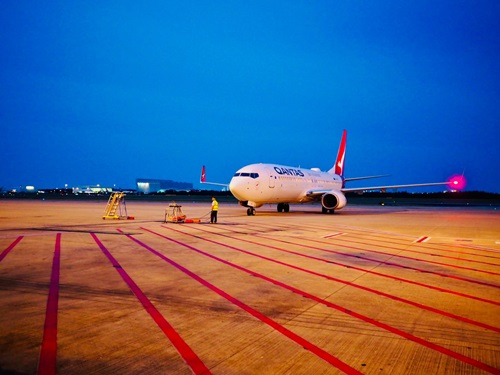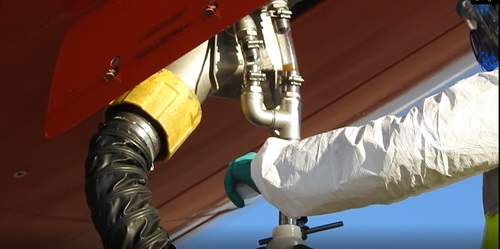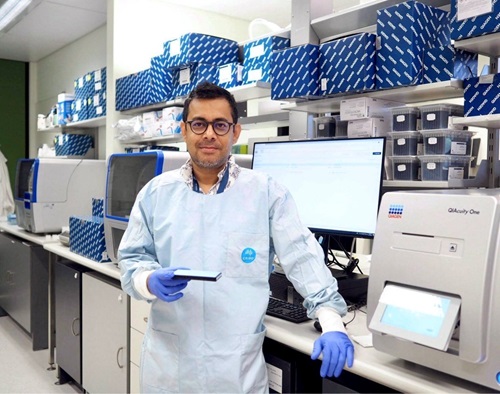The world-leading research from CSIRO scientists, working with Qantas and The University of Queensland, demonstrates that wastewater surveillance can provide valuable data for public health agencies and help improve confidence in Australia’s safe reopening to the world.
CSIRO lead author Dr Warish Ahmed said as global travel returns, wastewater testing of flights can be an effective way to screen incoming passengers for COVID-19 at points of entry.
“It provides an extra layer of data, if there is a possible lag in viral detection in deep nasal and throat samples and if passengers are yet to show symptoms,” Dr Ahmed said.
“The rapid on-site surveillance of wastewater at points of entry may be effective for detecting and monitoring other infectious agents that are circulating globally and provide alert to future pandemics.”
Professor Jochen Mueller from UQ’s Queensland Alliance for Environmental Health Sciences and co-author on the research said wastewater testing could be a useful additional tool.
“The paper recommends that wastewater surveillance should be used as part of an efficient clinical surveillance and quarantine system – providing multiple lines of evidence of the COVID-19 infection status of passengers during international travel,” Prof Mueller said.
“Wastewater surveillance from large transport vessels with their own sanitation systems significantly improves our ability to control the spread of infection from overseas travellers.”
Published today in Environment International, the study analysed wastewater samples from lavatories of 37 Australian Government repatriation flights from COVID-hotspots including India, France, UK, South Africa, Canada and Germany landing at Darwin International Airport between December 2020 and March this year.
The research found wastewater samples from 24 of the 37 repatriation flights (65 per cent) showed a positive signal for the virus that causes COVID-19 despite all passengers (except children under age five) testing negative to the virus 48 hours before boarding.
Infected people shed the virus in their faeces about two to five days before showing symptoms. Traces of COVID can also be detected in wastewater from people who were previously infected, still shedding the virus, but are no longer infectious to others (although this is typically a weaker signal).
During 14 days of mandatory quarantine after arriving in Australia, clinical tests identified only 112 cases of COVID-19 among the 6570 passengers (1.7 per cent).
There was 87.5 per cent agreement between the positive detections by surveillance of the wastewater (i.e., detection of SARS-CoV-2 RNA) and the subsequent clinical detections made during the passengers quarantine.
This was the first official study of wastewater from Australian repatriation flights returning from hot spots and the first time researchers have matched the plane wastewater testing with the follow-up clinical data testing of passengers in quarantine.
For the study, CSIRO undertook the wastewater analyses, and much of the data analysis with input on from University of Notre Dame, USA. Qantas designed the sampling trap with input from The University of Queensland and both organizations were involved in study design and wastewater sampling.
The participants of this study were quarantined at the Howard Springs Quarantine Facility in the Northern Territory.
The latest study builds on work from an earlier paper published in the Journal of Travel Medicine in July 2020, which detected fragments of the SARS-CoV-2 virus in aircraft and cruise ships.
According to the latest paper, surveillance of wastewater from aircraft and cruise ships offers a convenient and cost-effective means of monitoring infectious agents that could be globally scaled to detect and manage the importation of disease.
For more information visit: https://www.csiro.au/en/research/health-medical/diseases/COVID-19-research/Monitoring-wastewater
Images



Videos
[Music plays and a split circle appears, and images move through each half of the circle of photos of different CSIRO activities, and then the image morphs into the CSIRO logo]
[Image changes to show a view of researchers working in a lab, and then the camera zooms in to show a close view of a researcher, a machine, and a lab coat being taken from a hook]
Narrator: CSIRO researchers have developed a set of sensitive methods for detecting SARS COVID-2 genetic fragments in wastewater.
[Images move through to show a researcher putting on a lab coat, a close view of the researcher putting on gloves, the researcher operating a machine, and a researcher working on a computer]
An important aspect of wastewater surveillance is the ability to rapidly and cost effectively divert data from a large population across thousands of individuals,
[Image changes to show a hazard sign in the laboratory, a close view of a biohazard sign, a close view of tweezers being placed in a Bunsen burner flame, and a hand shaking a sample in a bottle]
with enough potential sensitivity to detect a small number of infected individuals contributing SARS COVID-2 RNA into the local wastewater systems.
[Image shows the bottle being unscrewed, and then images move through of liquid being poured into a clear glass container, a container being put into a machine, and the lid of the machine being closed]
This pooling concept can be particularly important for regions with no clinical COVID-19 testing rates, minimal resources, or no known cases.
[Images move through to show a sample being put into a machine, a researcher operating the machine, the Ecosciences Precinct building, and a rear view of a male entering a building]
We receive up to 100 wastewater samples a week from 45 wastewater treatment plants across Queensland. Delivery of samples is managed by our collaborators from University of Queensland.
[Images move through of a researcher taking a test tube from a tray, a test tube being filled, and a researcher picking up a disc with tweezers and placing it on the top of a glass type funnel]
The sample analysis process is complex and involves many steps and specialised instruments.
[Image changes to show a researcher placing a clamp around a glass funnel, and then the image changes to show the researcher pouring liquid into a glass jug at the top of the apparatus]
SARS COVID-2 are typically diluted in wastewater considering the small number of cases in Queensland.
[Image changes to show a close view of the liquid being poured, a close view of the apparatus being used, and a glass funnel on the apparatus]
So, detecting this virus requires a concentration step. This step is very crucial for trace detections.
[Image changes to show a researcher with three sample jugs on top of three Bunsen burners and the camera zooms in on one of the sample jugs]
We have refined several virus concentration methods to achieve the best results.
[Images move through to show a sample being put inside a test tube, a female researcher placing a long syringe into the test tube, and then a close view of liquid being drawn up into the syringe]
We use these methods based on the sample type for the sensitivity required and urgency of test results.
[Image changes to show two samples in a tray, and then the image changes to show the samples being placed into a machine, and then the image changes to show a hand operating a control panel]
After virus concentration we extract RNA, which is a small genetic fragment of the SARS COV-2 virus.
[Image changes to show the machine vibrating the sample tubes, and then the image changes to show a researcher looking at the sample tube]
This fragment is not infectious.
[Images move through to show a sample being put into a machine, a male researcher working on a computer, his hand on the mouse, and then the screen he is working on]
Once the run is completed critical analysis of results take place, the samples are cross checked alongside all quality controls to verify the result and then we report it to Queensland Health.
[Camera zooms in on the digital images on the screen he is working on]
And this is one of CSIRO’s responses to the management of the current pandemic.
[Music plays and the image changes to show the CSIRO logo and text appears: CSIRO, Australia’s National Science Agency]
- View transcript
- Copy embed code






